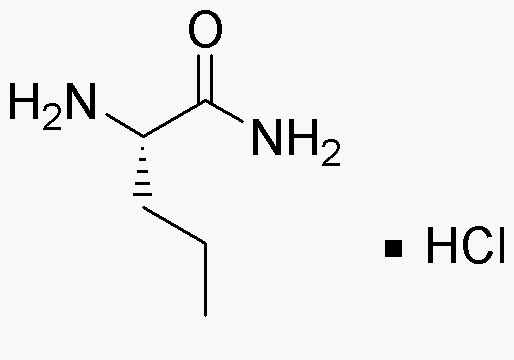L-Norvaline amide hydrochloride is widely utilized in research focused on:
- Biochemical Research: It serves as a valuable tool in studying protein synthesis and metabolism, particularly in understanding the role of amino acids in cellular functions.
- Pharmaceutical Development: This compound is explored for its potential in drug formulations, especially for conditions related to metabolic disorders, due to its unique structural properties.
- Neuroscience: Researchers investigate its effects on neurotransmitter activity, which may lead to advancements in treatments for neurological conditions.
- Sports Nutrition: It is being studied for its potential benefits in enhancing muscle recovery and performance, making it of interest to athletes and fitness professionals.
- Cosmetic Formulations: The compound is also explored for its possible applications in skincare products, where it may contribute to improved skin health and hydration.
General Information
Properties
Safety and Regulations
Applications
L-Norvaline amide hydrochloride is widely utilized in research focused on:
- Biochemical Research: It serves as a valuable tool in studying protein synthesis and metabolism, particularly in understanding the role of amino acids in cellular functions.
- Pharmaceutical Development: This compound is explored for its potential in drug formulations, especially for conditions related to metabolic disorders, due to its unique structural properties.
- Neuroscience: Researchers investigate its effects on neurotransmitter activity, which may lead to advancements in treatments for neurological conditions.
- Sports Nutrition: It is being studied for its potential benefits in enhancing muscle recovery and performance, making it of interest to athletes and fitness professionals.
- Cosmetic Formulations: The compound is also explored for its possible applications in skincare products, where it may contribute to improved skin health and hydration.
Documents
Safety Data Sheets (SDS)
The SDS provides comprehensive safety information on handling, storage, and disposal of the product.
Product Specification (PS)
The PS provides a comprehensive breakdown of the product’s properties, including chemical composition, physical state, purity, and storage requirements. It also details acceptable quality ranges and the product's intended applications.
Certificates of Analysis (COA)
Search for Certificates of Analysis (COA) by entering the products Lot Number. Lot and Batch Numbers can be found on a product’s label following the words ‘Lot’ or ‘Batch’.
*Catalog Number
*Lot Number
Certificates Of Origin (COO)
This COO confirms the country where the product was manufactured, and also details the materials and components used in it and whether it is derived from natural, synthetic, or other specific sources. This certificate may be required for customs, trade, and regulatory compliance.
*Catalog Number
*Lot Number
Safety Data Sheets (SDS)
The SDS provides comprehensive safety information on handling, storage, and disposal of the product.
DownloadProduct Specification (PS)
The PS provides a comprehensive breakdown of the product’s properties, including chemical composition, physical state, purity, and storage requirements. It also details acceptable quality ranges and the product's intended applications.
DownloadCertificates of Analysis (COA)
Search for Certificates of Analysis (COA) by entering the products Lot Number. Lot and Batch Numbers can be found on a product’s label following the words ‘Lot’ or ‘Batch’.
*Catalog Number
*Lot Number
Certificates Of Origin (COO)
This COO confirms the country where the product was manufactured, and also details the materials and components used in it and whether it is derived from natural, synthetic, or other specific sources. This certificate may be required for customs, trade, and regulatory compliance.


